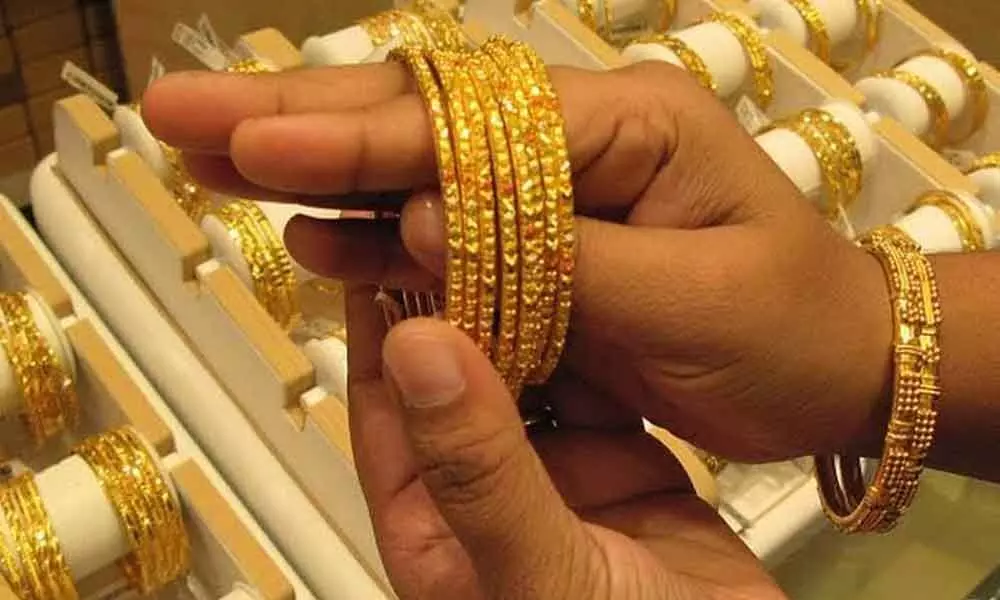Live
- US extends condolences to those affected by quake in Tibet
- Drink coffee during morning hours to get good heart health
- Farmers urge CM to focus on projects
- IAF Chief Raises Alarm Over Militarisation At India's Borders Amid China's Rapid Advancements
- 23 BC hostel students suffer food poisoning
- Yuva Kabaddi Series: Aravalli Arrows beat Palani Tuskers; Murthal Magnets get first win in Division 1
- Thailand receives over 35.5 million foreign tourists in 2024
- Why BJP hasn’t taken action against Bidhuri, asks Bhatti
- 'Has endeared himself to people of Tripura', PM Modi extends birthday wishes to CM Manik Saha
- IOA treasurer raises concern over pending games allotment fee for 38th National Games
Just In
India's gold demand falls 9% on record prices in 2019: World Gold Council


India's gold demand fell nine per cent to 690.4 tonnes in 2019 from the previous calendar year as record domestic prices and economic slowdown dented retail purchase, the World Gold Council (WGC) said on Thursday.
NEW DELHI: India's gold demand fell nine per cent to 690.4 tonnes in 2019 from the previous calendar year as record domestic prices and economic slowdown dented retail purchase, the World Gold Council (WGC) said on Thursday.
However, in 2020, gold demand in India -- the world's second biggest consumer after China -- could increase to 700-800 tonnes on hopes of increased acceptance of high price level and likely economic reforms boosting consumer confidence.
The domestic gold price finished 2019 just above Rs 39,000 per ten grams, almost 24 per cent higher than at the end of 2018, WGC said in its latest report.
"As policy measures unfold, broader economic growth accelerates and local prices of the past six months become more acceptable among households, India's gold demand will be in the range of 700-800 tonnes in 2020," Somasundaram PR, Managing Director of WGC's India operations, told PTI.
The WGC expects policy-led and industry-led initiatives to bring a marked shift in making the industry more transparent and organised this year, he said.
Already, the government has made hallmarking (quality certification) mandatory on January 15, 2020 with a transition period of one year for the trade to sell or change its existing non-hallmarked inventory. This is an overdue reform and a positive step towards making the Indian gold more trustworthy, he said.
"These and other changes to follow are significantly positive for the long-term sustainability of demand, especially for the compliant and the organised sector," Somasundaram said.
However, short-term challenges remain as large sections of the industry compete on low margins and fear tax uncertainty, leaving little incentive for long term investments and modern trade practices, he said.
"India's average long-term gold demand is likely around 850 tonnes given its affinity to gold and economic and social context," he added.
In 2019, the WGC said India's gold demand in volume terms declined to 690.4 tonnes from 760.4 tonnes in 2018, out of which jewellery demand fell nine per cent to 544.6 tonnes from 598 tonnes, while bar and coins demand also dropped 10 per cent to 145.8 tonnes from 162.4 tonnes in the said period.
However in value terms, the country's gold demand rose three per cent to Rs 2,17,770 crore in 2019 from Rs 2,11,860 crore in the previous year.
"Dhanteras – the first day of Diwali (the Festival of Light) which fell on October 25, 2019 – failed to bring cheer to gold demand in Q4 as the higher domestic gold price and weak economic sentiment curtailed gold sales," the WGC said.
Festival demand received some support from advance wedding purchases and a dip in the gold price ahead of the November wedding season released some pent-up wedding-related demand, but volumes were nevertheless soft compared with 2018, it said, and added, the slowdown was less pronounced among the more organised national and regional chain stores
India's gold import including through grey channels, the WGC said it declined by 14 per cent to 646.8 tonnes in 2019 from 755.7 tonnes in 2018. Imports through grey market stood at 115-120 tonnes in 2019.
"Imports remained lower due to softening of local demand and 37 per cent increase in recycled gold to 119 tonnes in 2019," Somasundaram said.
"We do believe imports may not rise as fast as demand this year. But do expect custom duty on gold to be reduced to 10 per cent from 12.5 per cent at present."
Two-thirds of India's gold demand comes from rural areas, where jewellery is a traditional store of wealth.

© 2024 Hyderabad Media House Limited/The Hans India. All rights reserved. Powered by hocalwire.com






